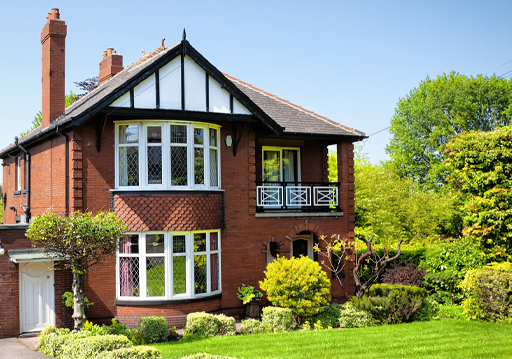1.3 Viktoriia visits Mary
Now listen to Mary showing Viktoriia around her house.
Transcript: Audio 5
| Ukrainian | Transliteration |
|---|---|
| Вікторія Добрий день, Мері! | Viktoriia Dobryi den, Meri! |
| Мері Привіт, Вікторіє! | Meri Pryvit, Viktoriie! |
| Вікторія Можна зайти? | Viktoriia Mozhna zaity? |
| Мері Так, звичайно! Ласкаво просимо! Дякую за квіти! | Meri Tak, zvychaino! Laskavo prosymo! Diakuiu za kvity! |
| Вікторія Дуже гарний будинок! | Viktoriia Duzhe harnyi budynok! |
| Мері Дякую, проходь! Це вітальня, далі – їдальня, кухня, кабінет і туалет. | Meri Diakuiu, prokhod! Tse vitalnia, dali – yidalnia, kukhnia, kabinet i tualet. |
| Вікторія О, як гарно! | Viktoriia O, yak harno! |
| Мері Далі сходи. Угорі спальні і ванна. Там є балкон. | Meri Dali skhody. Uhori spalni і vanna.Tam ye balkon. |
| Вікторія У тебе чудовий будинок! А у вас є сад? | Viktoriia U tebe chudovyi budynok! A u vas ye sad? |
| Мері Так, сад і квітник. Ходімо в сад! | Meri Tak, sad i kvitnyk. Khodimo v sad! |
| Вікторія Ти і твій чоловік – чудові господарі! | Viktoriia Ty i tvii cholovik – chudovi hospodari! |
| Мері Дякую! | Meri Diakuiu |
Now listen to the audio explanation.
Transcript: Audio 6
Take a closer look (Audio 6 transcript)
You’ll also find the audio version of this explanation useful, for the pronunciation and to listen to when you are on the go!
Let’s look at this dialogue closely. Viktoriia pops to Mary’s home. The dialogue starts with classic greetings: Dobryi den, Meri! – Pryvit, Viktoriie! Then Viktoriia says: Mozhna zaity? which means ‘May I come in?’. Please repeat once again: Mozhna zaity? Mary replies: Tak, zvychaino! Laskavo prosymo! Diakuiu za kvity! which means ‘Yes, of course! Welcome! Thank you for the flowers!’ Let’s repeat these three sentences slowly together: Tak, zvychaino! __________________(‘Yes, of course!’), Tak, zvychaino! ______________. The next phrase is ‘ Welcome’: Laskavo prosymo!_________________,Laskavo prosymo! ___________ And last sentence – ‘Thank you for the flowers!’: Diakuiu za kvity! __________________, Diakuiu za kvity! ________________.
Viktoriia expresses her first impression of Mary’s house: Duzhe harnyi budynok! which means ‘Very nice house!’ Harnyi is ‘nice, beautiful’, budynok is ‘house’. Let’s repeat these words together: harnyi____________, budynok ______________;harnyi budynok.
Mary replies: Diakuiu, prokhod! which means ‘Thank you, come in!’ New word for you here is prokhod (‘come in!’). This is singular form. Plural form is Prokhodte. Let’s repeat these words together: prokhod ____________(singular), prokhodte _____________(plural).
After this Mary shows her house to Viktoriia. Let’s see how she is doing this. Mary says: Tse vitalnia, dali – yidalnia, kukhnia, kabinet i tualet, which means ‘This is a living-room, then there’s the dining-room, kitchen, office and a toilet’.
Viktoriia replies: O, yak harno! which means ‘Oh, how nice!’
Mary continues her home tour: Dali skhody. Uhori spalni і vanna, which means ‘Further on are the stairs. Bedrooms and a bathroom are upstairs.’ Let’s look at this attentively. Dali skhody literally means ‘further stairs’. Then Mary says: Uhori spalni i vanna which means ‘There are bedrooms and a bathroom upstairs.’ Mary finishes her tour: Tam ye balkon which means ‘There is a balcony there’. Tam means ‘there’. Let’s repeat this word: tam ____, tam _____. Let’s return to the last sentence again: Tam ye balkon. Ye is present tense of the verb to be in Ukrainian (the same form for all persons, both singular and plural). I hope you remember that usually verb ‘to be’ is avoided in Ukrainian in present tense. It is used to stress presence of something or having something.
Viktoriia replies: U tebe chudovyi budynok! which means ‘You have a wonderful house!’ and asks: A u vas ye sad? (‘Do you have a garden?’)
Mary replies: Tak, sad i kvitnyk. Khodimo v sad! (‘Yes, a garden and a flowerbed. Let’s go to the garden!’). Useful new word for you here is khodimo (‘let’s go!’). Please repeat it with me: khodimo _______, khodimo _________.
Looking at the garden, Viktoriia says: Ty i tvii cholovik – chudovi hospodari! (‘You and your husband are wonderful homemakers !’) Hospodariis plural of hospodar – a person who leads a family, a household, or a homemaker. Mary replies: Diakuiu! (‘Thank you!’)
Now listen to the dialogue once again.

